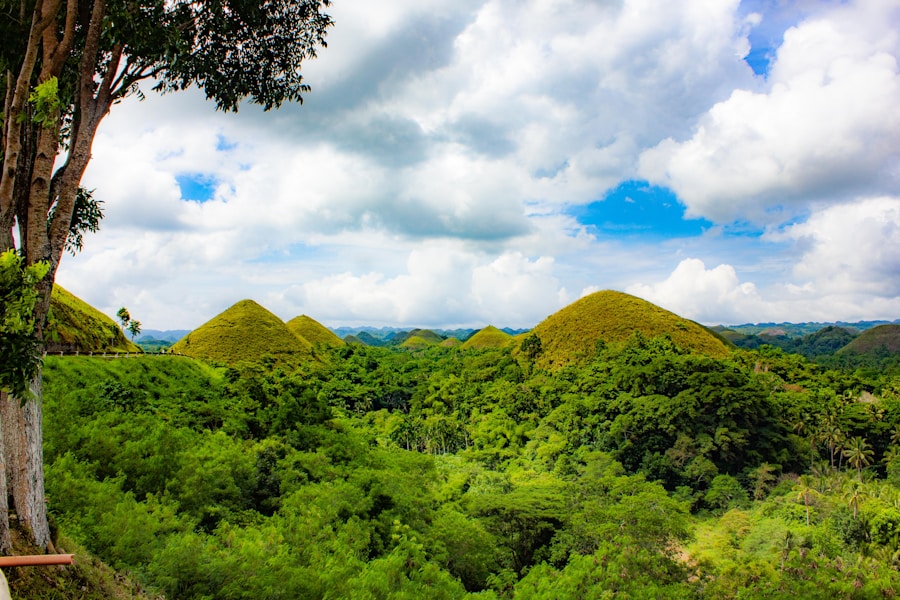Download links
How to install Exploring the Enigmatic Chocolate Hills APK?
1. Tap the downloaded Exploring the Enigmatic Chocolate Hills APK file.
2. Touch install.
3. Follow the steps on the screen.
Description
The Chocolate Hills, a geological wonder located in the Bohol province of the Philippines, have long captivated the imagination of both locals and tourists alike. Their unique conical shapes and verdant green hues that turn a rich brown during the dry season have led to various theories regarding their origin. One of the most widely accepted explanations is that these hills are the result of the uplift of coral deposits and limestone, shaped over millennia by the forces of erosion.
This process, which began millions of years ago, involved the gradual wearing away of softer materials, leaving behind the more resilient limestone formations that we see today. However, local folklore adds an intriguing layer to the hills’ origin story. According to one popular legend, the hills were formed from the tears of a giant who fell in love with a mortal woman.
This romantic tale not only highlights the cultural significance of the Chocolate Hills but also reflects the deep connection that the local population has with their natural environment. The blend of scientific explanation and mythological narrative contributes to the allure of this natural wonder, making it a focal point for both geological study and cultural storytelling.
Key Takeaways
- The Chocolate Hills in the Philippines have a mysterious origin that has puzzled scientists for centuries.
- The unique geological formation of the Chocolate Hills is characterized by over 1,200 cone-shaped hills spread across the landscape.
- The Chocolate Hills are home to a diverse range of flora and fauna, including rare and endemic species.
- The cultural and historical significance of the Chocolate Hills is deeply rooted in local folklore and legends.
- The best ways to explore the Chocolate Hills include hiking, biking, and taking guided tours to fully appreciate their beauty and significance.
- Conservation efforts are crucial for the preservation of the Chocolate Hills, as they face threats from deforestation and tourism activities.
The Unique Geological Formation of the Chocolate Hills
The geological formation of the Chocolate Hills is a fascinating subject that showcases the dynamic processes of nature. Spanning approximately 50 square kilometers, this landscape consists of over 1,200 individual hills, though estimates suggest there could be as many as 1,700. These hills vary in height, with some reaching up to 120 meters.
The uniformity in their shape and size is a testament to the erosional processes that have sculpted them over time. The hills are primarily composed of limestone, which is rich in calcium carbonate and formed from ancient coral reefs that thrived in a shallow sea millions of years ago. The unique topography of the Chocolate Hills is attributed to a combination of geological factors, including tectonic activity and weathering.
The uplift of limestone deposits created a plateau that was subsequently eroded by rainwater and surface runoff. This erosion process has been ongoing for thousands of years, resulting in the smooth, rounded shapes that characterize the hills today. The region’s tropical climate plays a significant role in this process; heavy rainfall during the wet season accelerates erosion, while dry periods allow for vegetation to flourish, further stabilizing the soil.
The interplay between these natural forces has resulted in a landscape that is not only visually stunning but also geologically significant.
Flora and Fauna of the Chocolate Hills

The biodiversity surrounding the Chocolate Hills is as remarkable as their geological features. The area is home to a variety of plant species that thrive in its unique environment. During the rainy season, lush green grass covers the hills, creating a vibrant landscape that attracts numerous species of wildlife.
Grasses such as cogon grass (Imperata cylindrica) dominate the hillsides, while various flowering plants add splashes of color to the scenery. As the dry season approaches, these grasses turn brown, resembling chocolate mounds—hence the name “Chocolate Hills.” In addition to its plant life, the region supports a diverse array of animal species. Birds are particularly abundant in this area; species such as the Philippine tarsier, one of the world’s smallest primates, can be found in nearby forests.
These nocturnal creatures are known for their large eyes and unique ability to rotate their heads almost 180 degrees. Other wildlife includes various reptiles and insects that contribute to the ecological balance of this unique habitat. The presence of these species highlights the importance of preserving not only the hills themselves but also the surrounding ecosystems that support them.
Cultural and Historical Significance of the Chocolate Hills
| Aspect | Metric |
|---|---|
| Number of Hills | 1,268 |
| Height of Hills | 30 to 50 meters |
| Formation | Geological uplift and coral deposits |
| Cultural Importance | Sacred to the local Boholano people |
| Legend | Associated with a tragic love story |
The Chocolate Hills hold significant cultural and historical value for the people of Bohol. They are not merely a natural wonder; they are woven into the fabric of local folklore and traditions. The hills are often featured in local stories and legends, serving as symbols of love and loss, as well as resilience and beauty.
This cultural significance is reflected in various festivals and events held in Bohol, where locals celebrate their heritage and connection to this iconic landscape. Historically, the Chocolate Hills have also played a role in shaping Bohol’s identity. They have become a source of pride for residents and a key attraction for tourists, contributing to the local economy through ecotourism.
The hills are often included in travel itineraries for visitors seeking to experience Bohol’s natural beauty and cultural richness. Additionally, they serve as a reminder of Bohol’s geological history and its evolution over millions of years, making them an important site for scientific research and education.
Best Ways to Explore the Chocolate Hills
Exploring the Chocolate Hills offers visitors a chance to immerse themselves in one of nature’s most extraordinary landscapes. One popular way to experience this natural wonder is by visiting the Chocolate Hills Complex, which features viewing platforms that provide panoramic views of the hills. From these vantage points, visitors can appreciate the sheer scale and beauty of this geological formation while capturing stunning photographs.
For those seeking a more adventurous experience, hiking trails around the hills offer opportunities for exploration on foot. Guided tours can provide insights into the geological history and ecological significance of the area while allowing visitors to engage with nature up close. Additionally, biking through the surrounding countryside can be an exhilarating way to take in the sights while enjoying fresh air and exercise.
Whether by foot or bike, exploring the trails around the Chocolate Hills allows visitors to appreciate not only their beauty but also their intricate relationship with the surrounding environment.
Conservation Efforts for the Preservation of the Chocolate Hills
Protecting a Unique Landscape
As awareness grows regarding environmental conservation, efforts to preserve the Chocolate Hills have become increasingly important.
Conservation programs focus on sustainable tourism practices that minimize environmental impact while promoting awareness about the ecological significance of the area.
Community Involvement and Education
Community involvement plays a crucial role in these conservation efforts. Local residents are encouraged to participate in initiatives aimed at protecting their natural heritage while benefiting economically from tourism. Educational programs help raise awareness about responsible tourism practices among visitors, emphasizing respect for nature and local culture.
A Shared Responsibility
By fostering a sense of stewardship among both locals and tourists, these efforts aim to ensure that future generations can continue to enjoy and learn from this remarkable geological wonder. In conclusion, the Chocolate Hills stand as a testament to nature’s artistry and resilience. Their mysterious origins, unique geological formations, rich biodiversity, cultural significance, exploration opportunities, and ongoing conservation efforts all contribute to their status as one of the Philippines’ most iconic landmarks.
A Call to Action
As we continue to explore and appreciate these hills, it is essential to recognize our responsibility in preserving them for future generations to admire and cherish.
If you’re interested in learning more about unique natural wonders like the Chocolate Hills, you may want to check out this article on the most highly rated travel apps here. These apps can help you plan your next adventure to see amazing sights like the Chocolate Hills in the Philippines.
FAQs
What are the Chocolate Hills?
The Chocolate Hills are a geological formation located in the Bohol province of the Philippines. They are made up of around 1,200 to 1,776 conical limestone hills, which are covered in green grass that turns brown during the dry season, giving them a chocolate-like appearance.
How were the Chocolate Hills formed?
The exact formation process of the Chocolate Hills is still a subject of debate among geologists. However, it is widely believed that they are the result of the uplift of coral deposits and the action of rainwater and erosion over millions of years.
What is the significance of the Chocolate Hills?
The Chocolate Hills are a major tourist attraction in the Philippines and are considered a natural wonder. They have been declared the country’s third National Geological Monument and are also proposed for inclusion in the UNESCO World Heritage List.
Can visitors explore the Chocolate Hills?
Yes, visitors can explore the Chocolate Hills by climbing to the top of some of the hills, where they can enjoy panoramic views of the surrounding countryside. There are also viewing decks and platforms for tourists to take in the beauty of the landscape.
Is there any wildlife in the area of the Chocolate Hills?
The area surrounding the Chocolate Hills is home to a diverse range of flora and fauna, including various species of birds, butterflies, and plants. The hills are also part of the Chocolate Hills Complex, which includes a protected area for wildlife conservation.






